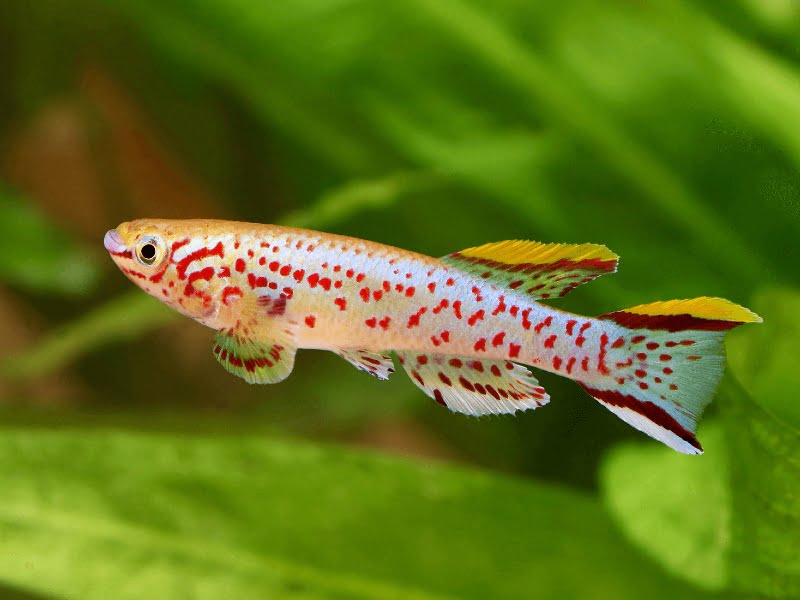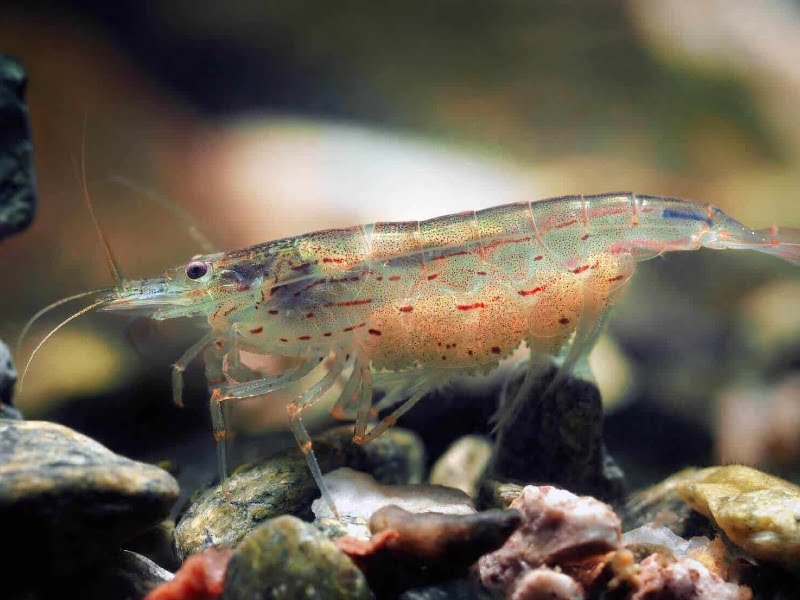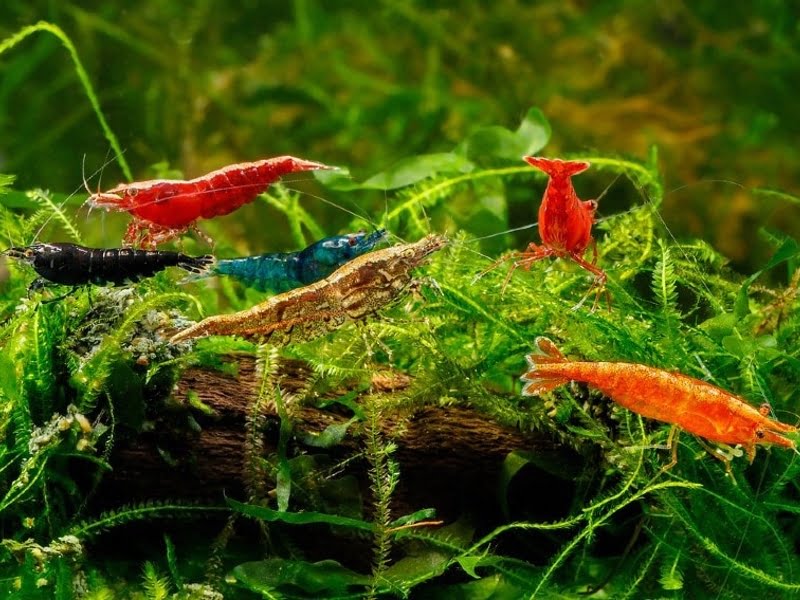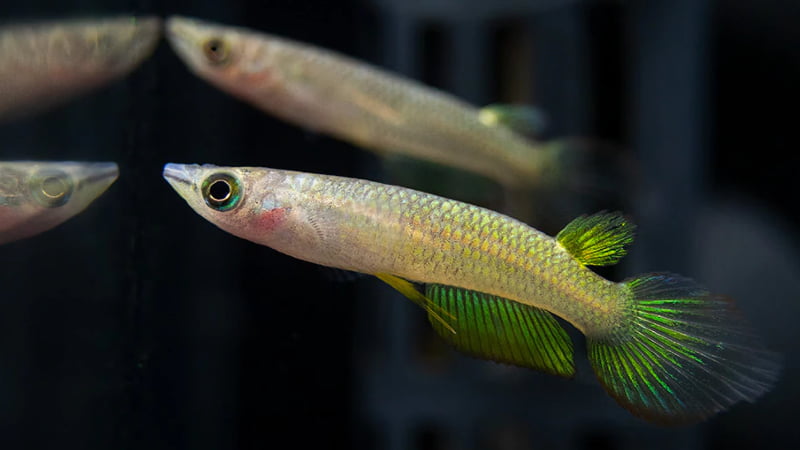Killifish and shrimp are two pet species that a lot of people ask about it in recent times.
A fish tank that can house multiple types of fish is a substantial improvement over one that only houses one type. Especially, aquariums containing killifish and shrimp. The most significant question to ask yourself is, “How will killifish and shrimp get along?”.
I think the same is true when it comes to killifishes and shrimps as well. Is it true that killifish eat shrimps as well? Are there any problems between the two? It would be interesting to learn how this works!
Is Killifish Capable Of Eating Shrimp?
It is indeed true that most Killifish will eat Shrimp if they are presented with the right opportunity.
The reason for this is that this is possible in the fish tank simply by virtue of Killifish type, Shrimp type, and the ratio of one to another as well as the conditions that are provided for them in the fish tank.
Therefore, provided that the types of Killifish and Shrimp used in the aquarium are selected so that one does not harm the other, the ratios of both in the tank are adjusted, and they could live harmoniously together in the aquarium of their choice.
The following are a few key points that I have gathered information about in order to make an informed decision.
Your fish tank is sure to be a lovely, interesting place to keep creatures, but at the same time, you want to keep it safe at the same time!
Are All Killifish Shrimp Eaters?
While it is true that Killifish are known to eat just about anything that will fit in their mouths, not all species can be considered invasive species!
The size of the Killifish and the size of the Shrimp is something noteworthy that is worth paying attention to in this case.
There is a great deal of influence that the size of a species could have on the compatibility of the species. In the following paragraphs, let’s discuss what Killifish and Shrimps are so that we may understand them a little better.
Killifish

There are different species of killifish, depending on their body shape and size. As a rule of thumb, most Killifish are 1 – 1.5 inches in length, while some can attain lengths of over 6 inches.
Due to their ability to survive and reproduce in an environment that is unconditional, they are also one of the most fascinating fish species on earth.
The Killifish species vary greatly in how long they can survive when they are out of the water. Some can survive for months without any water, and others can survive in fish ponds or streams that dry up for most of the year.
In addition to territorial behavior, Killifish also display behaviors that can be differentiated between male and female.
Although they have a tendency to occupy only the top portion of the aquarium, they can be easily kept because they tend to occupy only the top section.
Consequently, the other fish species in the tank, situated in the lower sections of the tank, have space so they can provide a good home for their pups in the lower portions of the tank.
The Killifish also like to feed on arthropods that live in the water. In conclusion, they eat mainly worms, insect larvae, and shrimps as well as other varieties of aquatic crustaceans.
Shrimp
When it comes to adding freshwater aquarium Shrimps to your fish tank, if you are looking for something unique, then freshwater aquarium Shrimps may be the answer.
A freshwater shrimp is also quite popular among aquarists as an algae eater, since those shrimp have the ability to consume algae in abundance.
The small size of freshwater shrimp is of course what makes them prone to falling prey to much larger fish in their tank, despite their active presence.
The size of an adult male freshwater Shrimp, however, is usually what determines their ability to remain safe in a fish tank since they don’t usually grow too much longer than 1.5 inches while female freshwater Shrimps usually reach a size of around 2 inches.
As to the size of the Shrimps, it is useful to remember that they can be anywhere between a few millimetres to eight inches in length.
I thought that a killifish that is 6 inches long might be able to eat a shrimp that is 8 inches long but doesn’t seem likely. It will be interesting to see what happens.

Killifish And Shrimp
In order to have a harmonious existence between the Killifishes and the Shrimps in a fish tank, their sizes are by far the most important factor.
Since Killifishes are naturally inclined to feed on crustaceans, due to the breed of Killifish, and due to the fact that freshwater Shrimps are smaller than Killifish, it is easy to understand that Killifish would feed on Shrimps.
The following shrimps can usually be safe from the killifish (as long as they are less than 3 inches long).
Several types of this type of shrimp can be found in Hawaii, such as Amano Shrimps, Singapore Flower/Bamboo Shrimps, Green Lace Filter Shrimps, and Vampire Shrimps in various sizes, which measure between 2 and 3 inches in length.
It is because of the slightly larger size of these specific Shrimp species that they are not an issue when it comes to Killifishes.
In contrast, the clown killifish, a type of predatory fish, is comparatively less aggressive towards Shrimps than other kinds of killer fish.
You can also find the best tankmates for both killifish and shrimp below along with the information on which tankmates are suitable for them.
The Best Way To Keep Shrimps And Killifish Together
Let us move on to the next step in our conversation now that we know more about the characteristics of Killifish and Shrimps.
Nonetheless, I have listed some strategies below that can be used to keep killifish and shrimp separate from each other.
A Guide To Killifish And Shrimp Sizes
As announced earlier, keeping an aquarium full of shrimp that are large enough to outweigh the Killifish is the best way to keep them safe.
There is a low probability that your Killifish will attack your Shrimp when your Shrimp is larger, which is the case if your Shrimp is bigger.
The best solution, however, would be to look into getting a completely separate tank if you have Shrimp fry living in the same tank.
The shrimp and the killifish can be separated in this manner and they will be able to grow together on their own.
It is possible to keep smaller Shrimp species in the same aquarium as your Killifish species, but which species will you place in there? The following four suggestions may help you with that decision.
An Abundantly Planted Tank
It is possible that the majority of your Shrimp will be safe from your Killifish if you have an abundance of plants in your fish tank.
There are several types of plants that are perfect for thriving in an aquarium. One of them is moss. Marimo moss is an extraordinary, natural product that is bigger in size than any other mosses.
In a tank that has such dense plants, your shrimp, especially those that are in their fry stage, will be able to hide from predators.
This will allow them to survive into adulthood and allow them to reproduce more powerfully.
Food Should Be Provided To killifish
It may seem like a simple solution, yet this is something that is really important to remember.
As an example, if you feed your killifish with the right amount of food, there is much less chance that they will attack your shrimp to eat if you feed them appropriately.
So, in order for your Killifish to remain satisfied, the following foods must be eaten.
- Brine Shrimp.
- Mosquito Larvae.
- Daphnia.
- Worms.
- Fruit Flies.
- Paste Fish Foods.
Increase The Shrimp Number

It may surprise many people that this is a tactic that they haven’t thought of before.
The problem, however, may be that keeping more shrimp may make the Killifish feel outnumbered if there are too many of them.
It is possible to protect the largest portion of your Shrimp from your Killifish by doing this.
In this case, however, it may not have been as effective as the next suggestion in terms of making your Shrimp safe.
Shrimp Can Be Transferred To A Breeding Tank
To start off with, it is important to accept the fact that there is a natural tendency for larger aquatic species to attack smaller ones.
As a result, you should not be surprised when your Killifish starts to display predatory behavior toward Shrimps, as it is absolutely normal.
Some of the Shrimp from this tank may still be able to benefit from a breeding tank, however, if there is a possibility of this happening.
The plan of action that you need to take in order to do this is to replace the Shrimps that have been destroyed by your Killifish.
As I have said previously, this might seem harsh for you, but this is just the way things are.
Which Tankmates Are Best For Killifish?
As we search for suitable tankmates for Killifishes, we have to bear in mind two important things: first, they are good community fish, and second, they like close contact.
To help keep them happy, their tankmates must also be peaceful and small fish. Second, their tankmates need to have the same optimal water parameters as the Killifish require for their survival.
So, if this fish is supposed to live with a Killifish, this is the list of the best tankmates.
- Neon Tetras.
- Rummy Nose Tetras.
- Danios.
- Smaller Catfish.
- Rainbows and other peaceful fish.
In addition, it is often a good idea to dim a bit the lights in the tank to decrease the intensity of the glare since the fish mentioned above do not require a lot of light.
Nevertheless, one should keep in mind that the presence of a large number of plants in the aquarium will help to manage the fishes’ stress levels.
To ensure the survival of the plants, it is important that the lighting in the tank is also given priority.
Lastly, I would like to recommend that you cover your fish tank with a lid if possible. The Killifish are popular for their excellent jumping abilities, so this is important information.
Are Shrimps Compatible With Most Tankmates?
You should give the utmost priority to your Shrimps’ safety if you plan on keeping Shrimp in your aquarium.
In order to protect them, you must install plenty of plants in your aquarium so that they can easily hide from their predators, this can easily be done by installing a lot of plants in your aquarium.
Furthermore, below is a list of fish species that would make excellent tankmates for your Shrimp, if they were to live in the same aquarium.
- Catfish (Cory and Otocinclus.
- Freshwater Snails.
- Small Tetras.
- Dwarf Gouramis.
- Small Plecos.
Video About Killifish And Shrimp
FAQs
Killifish and shrimp are safe together?
There is no problem with killifish living with shrimps. In order to successfully keep shrimp and killifish together, it is necessary to keep the right sort of shrimp with the appropriate sort of killifish.
In addition, killifish might eat shrimp fry, so it’s essential to keep the right kind of shrimp.
Killifish are supposed to be paired up?
The male killifish can sometimes be aggressive towards each other in a community tank, even though the females are generally peaceful and get along well with each other.
It is for this reason that beginners are advised to keep a pair of Killifish in an aquarium that is only devoted to those fish.
Does clown killifish mix well with shrimp?
There are a number of fish that are too small for a clown killifish to eat most shrimp, although they will take shrimp eggs and tiny fries in the wild.
You should be able to keep your community setup clean and tidy by incorporating some shrimp into your aquarium, and they will not cause any bother to the Killifish.
Final Words
So, in order to keep Shrimps and Killifish in the same tank, it is critical that you take into consideration the sizes of the two fish.
Unless Shrimps are much bigger than Killifishes, they are much less likely to be in danger of being infected by Killifishes.
The tank also should be densely planted to allow the Shrimps to hide from the Killifish if there are too many weak spots in the tank.
It has also been suggested to provide adequate food for the Killifish, increase the number of shrimps in the tank, and even place some of the shrimps in a breeding tank for this purpose could help to find a solution to this problem.
Hence, after taking some of these necessary steps and keeping the fish and shrimp in a healthy environment, all you have to do is sit back and enjoy the show.
Using the capacity of the Killifish, you can prevent them from eating the Shrimp.

Annette M. Chaney is an experienced marine biologist with over 20 years of experience as an aquarist and fishkeeper. She started her first aquarium at a young age, filling it with frogs and goldfish obtained from the ten-cent pet store.
Annette grew up caring for and breeding African Cichlids, which led to a hobby in high school that doubled as a profitable means. Attending Reed College gave her time to solidify herself as an accomplished aquarium caretaker with an eye for sales. After that, from 2009 – 2013, she studied at Roger Williams University – one of the most prestigious universities for Aquaculture and Aquarium in USA. She is the founder of AquariumCircle since 2010.
